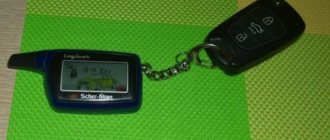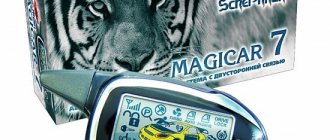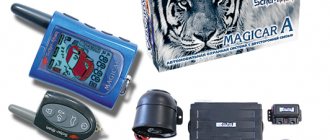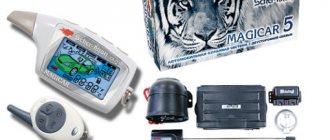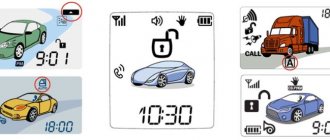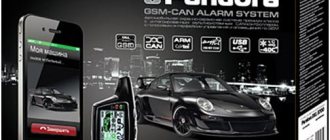Specifications
Security system characteristics:
- Control method - radio signal from key fobs with a frequency of 433.92 MHz (frequency error ±0.2%).
- Multifunctional communicator with display, two-way communication mode and four control and configuration buttons.
- The transmitter power in the control panel is not higher than 10 mW.
- The printed circuit board of the main unit is made using SMD technology and is equipped with four Magicar relays with an operating current of up to 30 Amps. Two relays are designed to control door locks, one for external light signaling and one to control the trunk lock circuit.
- Operating range is up to 1.5 km due to the use of FM modulation in the radio control channel.
- The power supply range for the circuit of the main unit with the processor is from 9 to 18 V (optimally 12 V).
- Current consumption in standby mode is up to 30 mA.
- Overall dimensions of the block – 244*116*39 mm.
- The weight of the device is no more than 0.27 kg.
- Possibility of operation at ambient temperatures from minus 40 ºС to plus 85 ºС.
- Sound alarm - using a siren. Current consumption is 2 A, sound duration is 0.5 minutes (one cycle).
- Visual alarm - hazard warning lamps. Control is carried out on both sides through separate circuits (current 7.5 A). The alarm flashes for 30 seconds at a frequency of 1 Hz.
The system protects electrical circuits from overloads using several methods:
- standard fuse links in the vehicle's mounting block;
- burnout resistances located inside the block;
- transistor protective assemblies;
- to protect against voltage surges and radio interference, the unit contains varistors;
- Diode protection is used against polarity reversal.
Functional Features
Scher Khan car alarms have gained worldwide popularity due to enhanced radio protection and a large range of up to 2 km, provided that there is no radio interference nearby. Data transfer is carried out between 2 devices: the central microprocessor unit and the pager. Models of this brand are suitable for different cars, regardless of the type of gearbox or engine. The main condition for their installation is the presence of a constant on-board voltage of 12 V. Among the protection levels used are:
- The processor is IP-40, which is installed inside the vehicle.
- Siren - IP-65 - is located in the engine compartment, away from metal components or electronic systems.
Multifunctional pagers equipped with 4 control buttons with support for operating modes are supplied with car alarms. The set of functions includes the following items:
- Protection against electronic hacking and signal interception.
- Possibility of synchronization of operating indicators.
- Feedback support.
- Displays accurate information about the current charge of the battery and batteries in the key fob.
- Possibility of programming functions from the pager.
- Monitoring the temperature inside the machine.
- Engine timer display.
- A number of other auxiliary functions.
The Sherkhan alarm microprocessor has advanced functionality; basic options are presented in the following groups:
- Enabling vehicle security mode. The driver has 2 ways to launch security functions: manual and automatic.
- Protection of the power unit in a neglected state. This mode is in demand when it is necessary to warm up the car while it is idle.
- Autostart. Sends startup commands after a specified time interval or due to changes in temperature and on-board voltage.
- Flexible setting of operating modes. The user is provided with ample opportunities to program the system.
Advantages and disadvantages of the manufacturer
If you read the reviews of car alarm owners from the Sherhan company, they will indicate both the pros and cons of this system. The advantages include:
- Two-way communication support.
- Large range of action - up to 1.5 km when controlled from a key fob.
- Hands-free option.
- Information screen.
- Availability of dynamic protection according to the Magic Code standard.
- Additional input for connecting useful sensors and accessories.
The list of negative points includes:
- No blocking of the power unit in case of breaking the hood lock.
- Poor engine protection in the absence of a standard immobilizer.
- Quite a high cost.
Main functions
The Magikar 6 system allows the owner to implement the following functions:
- the use of two individual channels to enable and disable security;
- the ability to program a code for access to the car interior without a key fob;
- adjustable delay mode for interior lighting;
- separate power outputs for door locks, trunk and alarm;
- the ability to automatically turn on the security mode;
- built-in write protection in the memory of the block of additional control panels (using a separate PIN code);
- automatic restoration of security if not a single limit switch on the doors is triggered;
- silent operation;
- hidden security mode (differs in the alarm being sent only to the key fob);
- built-in protection of the siren circuit against short circuit;
- the ability to control additional devices via two channels;
- customizable parameters for additional channels;
- the ability to use security functions when the power unit is running;
- turbo timer (ignition shutdown delay for two minutes);
- automatic opening and closing of locks when the ignition is turned off and on, respectively;
- possibility of two-stage door unlocking with driver's priority;
- the system allows you to open the trunk lock separately, keeping other zones under protection;
- the ability to measure temperature parameters in the cabin using a separate sensor.
Review of the Scher Khan Magicar 6 car alarm provided by the Arnage Shop channel.
Errors and their elimination
Common problems:
- The alarm does not respond to commands from the remote control. You should disassemble the key fob, clean it, and if necessary, re-solder the contacts. It is possible that the battery will need to be replaced.
- When the programming mode is turned on, the connection with the key fob is lost. It is recommended to dismantle the processor unit, clean its connectors and put it back.
- Lost communicator codes. It is necessary to re-enter the used key fobs into the system memory.
- Random activation of the call sensor. Perhaps you should reduce its sensitivity.
In the event of a major breakdown, repairs are carried out at a service center.
- Scher Khan instructions
- Magikar 10
- Magikar 5 installation instructions
- Scher Khan Magicar A
Advantages and disadvantages
Based on user reviews, we can highlight the positive and negative aspects of using the Scher Khan Magicar 6 “signaling system”.
Positive aspects:
- acceptable degree of protection;
- color LCD screen with clear icon layout;
- ease of operation and setup;
- the ability to configure using a computer with pre-installed proprietary software and a programmer;
- large range of operation of the system and key fobs;
- sensitive sensors;
- the ability to call the owner to the car;
- control via an additional channel of microwave cabin volume sensors;
- control of external lights and power windows (via an additional channel);
- the ability to open the car without a key fob (via a call sensor).
There are many negative points noted:
- low contrast due to the use of a dark substrate on the liquid crystal display (with the backlight turned off);
- fragile and thin body of key fobs (especially communication ones);
- requires the purchase of a programmer for configuration via a computer;
- high power consumption by the key fob in hands-free mode (compensated by using a rechargeable battery with a capacity of 1000 mAh as a battery);
- installation difficulties, for example, a separate connection of the engine starting system;
- volatile memory (resets when power is turned off);
- the owner's call sensor is unstable, especially at temperatures below minus 20 ºС;
- due to the high sensitivity of the shock sensor, it is difficult to determine the threshold value of the warning response;
- decreased range of action in dense urban areas;
- there are problem specimens with defective components (sometimes defects appear over time);
- the ability to scan and decipher the control code;
- there is no activation of the blocking of the engine starting and power supply circuits when the hood lock is broken;
- desynchronization of key fobs and the main unit (corrected by pressing the first button 35-40 times next to the car);
- To protect engine circuits, the system has only analog circuits, so it is recommended to use a standard immobilizer;
- failure of the key fob, which disables the two-way operation mode.
Scher-Khan 6 - a well-thought-out “two-sided without launching”
September 20, 2005
So, let's open the box and see what is offered in the Scher-Khan 6 kit. The alarm was announced as a reliable two-way car alarm without starting the engine. Indeed, if you pay attention to the statistics of installations of two-way car alarms with starting, it is striking that only in 20-30% of cases this engine starting is realized. Hence the question: why overpay for functions that are not implemented?
Whatever you say, it’s nice when the car alarm package includes everything to connect it. This is exactly the case here. It is especially worth noting that the one-sided keychain in all previous versions of Scher-Khan was purchased separately and was not cheap (about $20). Here it is included in the kit.
Let's take the main car alarm unit and, after some simple manipulations with a screwdriver, look under the body. We see that the board is made carefully, using SMD technology, however, like most modern car alarms. It is immediately noticeable that four proprietary, apparently very reliable, thirty-ampere (most car alarms use 20-ampere) Magicar relays are used here. Two relays for the central locking, 1 relay for the light alarm and 1 relay for unlocking the trunk.
Now let’s highlight the main differences between the “sixth Sherkhan” and previous versions, as well as the advantages and disadvantages of car alarms, both from the point of view of the car owner, and from the point of view of the installer and the alleged thief.
The first thing we should thank the manufacturer for is the separation of control of the disarm and arm modes on different buttons when using the proprietary Magic Code. Agree that although this is not a panacea for code selection, it will still complicate the hijacker’s task.
In the new alarm system, recording new key fobs into the system is only possible when entering a PIN code. This means that there is no possibility of introducing a new key fob capable of controlling a car alarm, for example, in a car service or at a car wash, when you leave the keys with key fobs and the car itself to strangers. In Scher-Khan Magicar V, a PIN code is not required to enter new key fobs into the system.
Unlike the fifth version of Scher-Khan, in the sixth it is possible to programmatically bind additional channels to events. For example, in the fifth version, in order to close the windows when arming, you had to press an additional button after turning on the “security” mode. In the sixth one you don’t have to do this - you just need to program an additional channel. That is, now there is no need to make unnecessary movements to implement, for example, such comfort functions as a “light path” (car headlights turn on after arming) or a “turbo timer” (two-minute cooling of the turbine at idle engine speed) and others.
The call sensor in the Scher-Khan 6 car alarm is designed to call the owner. It is attached to the car window. When you tap on the glass, a call is sent to the car alarm key fob. In the fifth version, one hit on the glass in the sensor area was enough, which sometimes led to false alarms. In Scher-Khan 6 you need to make a double weak blow.
I would also like to draw your attention to the presence, in the fifth version of Scher-Khan, of the ability to open the trunk lock in security mode, the presence of a temperature sensor, the readings of which are visible on the display of the double-sided key fob.
There is also a “hands-free” mode in which to arm and disarm you only need to approach or move away from the car with the key fob in your pocket. Since in this mode the key fob operates on the principle of a transponder tag, radio signal encoding is especially relevant here. We answer, it is dynamic. It should be noted, however, that in this mode the battery life is significantly reduced.
As in the fifth version, the sixth uses FM modulation of the radio channel, which allows you to increase the communication range between the alarm and the key fob in dense urban areas. According to the passport, the communication range is 1500 meters.
In conclusion, we note that like all Scher-Khan car alarms, this one is assembled in South Korea, and the reliability of the device can be the envy of many manufacturers of anti-theft equipment. Therefore, we recommend this device to our visitors.
Source
Installation Rules
The Scher Khan Magicar 6 alarm system is not difficult to install and configure, so car owners carry out the installation themselves.
During installation, you must follow the basic rules for installing security systems on cars:
- study the operating manual in detail;
- think over the installation scheme;
- use for installation of wires with an appearance as close as possible to standard wiring harnesses;
- ensure insulation of wires at the place of twists using electrical tape or heat-shrinkable tubes;
- when installing harnesses for controlling actuators on moving body elements, protective tubes should be used;
- do not allow kinks in the wiring or pinching by interior trim elements;
- Do not bend wiring harnesses through metal body panels with sharp edges;
- to route wiring into the engine compartment or trunk, use standard channels or separate bushings that protect the cables from chafing;
- to extend the wiring, it is allowed to use a product of a similar or larger cross-section;
- It is prohibited to use wires with aluminum or steel conductors;
- The installation sites of system elements must exclude the possibility of flooding with process liquids or water;
- It is recommended to place electrical connectors down or to the side, which will prevent condensation from accumulating;
- wiring harnesses should have slight slack;
- Alarm components should not be located near heat sources (exhaust manifold, air conditioner ducts, radiator);
- when placing elements and wiring harnesses, it is necessary to check that there are no interferences with moving mechanisms (steering column shaft, pedals, rods);
- The free play of the limit switch drives must be at least 5 mm (to reduce the likelihood of false alarms).
How to install?
Installation procedure:
- Disconnect the battery from the vehicle's on-board circuit.
- Remove the protective covers on the instrument panel and pillar trims (in accordance with the intended installation diagram).
- Place the processor unit in the instrument panel at a short distance from the main wiring harnesses. Since the device is equipped with vibration-sensitive electronic components, it must be rigidly attached to the body or instrument panel frame. Plastic ties or double-sided tape are used for fixation. The manufacturer does not recommend installing the device in the engine compartment, as well as on standard electronic units or in close proximity to them.
- Install the antenna on the windshield in a vertical position (to ensure maximum communication range). Most installers mount the device in the top corners of the glass, at least 5cm away from the metal body panels. It is permissible to install the antenna on the side fixed windows (rigidly installed in the body), sun visors, the surface of the rear window or the shelf underneath it. The unit is installed using double-sided tape at an air temperature of at least plus 10 ºС. To ensure reliable contact, it is recommended to degrease the installation site with alcohol or gasoline for lighters.
- Route the wiring harness from the antenna to the unit through the channels in the A-pillars.
- Place the owner call sensor on the windshield. The usual installation location is the bottom corners of the glass. The process of installing the sensor is similar to installing an antenna. The sensor body should not come into contact with body parts or plastic trim, as this increases the likelihood of false alarms. To adjust the sensor, there is a regulator with three fixed settings, indicated on the body by pictograms in the form of circles. The minimum level of sensitivity corresponds to a circle of small diameter, the maximum - to a large one.
- Place and secure the siren on the engine compartment mudguard or engine shield. When choosing a location, it is necessary to ensure that the device is protected from access from below (through the wheel arch or power unit protection screens). The horn should point downwards. When using an autonomous siren, quick and unhindered access to the control lock (used for shutdown) must be provided. Negative power is supplied from the car body (through a ground bolt or nut).
- Connect the siren wiring harness and lead it to the alarm unit.
- Install the end caps of the hood and trunk lids. The installation locations of the devices must have good contact with the surface of the body. The optimal places are areas that are protected by rubber seals. It is strictly prohibited to place limit switches in drainage channels.
- Lay the wires from the end switches to the main unit.
- Install a shock sensor in the cabin, which is attached with screws or double-sided tape. It is not recommended to place the device on plastic trim elements that are not rigidly attached to the body. The owner must have unhindered access to the sensor to configure it during operation.
- Install an additional sensor, if included in the kit or purchased separately.
- Connect ground power to the black wire from connector CN1 (main harness). The connection is made to the ground nuts on the body or directly to the battery terminal using a copper wire with a cross-section of 6-8 mm2.
- Connect the red wire from the connector to the positive power supply. It is possible to connect directly to the battery or by inserting a wire into the ignition switch circuit. The selected cable must provide voltage supply in any operating mode. The connection must be soldered and reliably insulated.
- Connect the remaining six wires of the CN1 connector to the trunk lock relay, the lock itself, the siren, and the hazard warning lights.
- Engage the wires of the CN2 connector, which controls the operation of the door locks. Connection diagrams are shown below. Connect the ten wires of the CN3 block. When connecting the harness to standard hood or trunk opening sensors, it may be necessary to install a diode decoupler. It is used in the operation of trunk lighting only when the side lights are functioning and consists of four diodes of type 1N4007 or similar Russian KD243A. The block contains wires (with orange and black insulation) that are responsible for warning about the lights not being turned off. The cables are activated at the request of the owner or installer.
- Connect the temperature sensor to the CN4 block and place it at a distance from the air conditioner ducts.
- Begin connecting the remaining wiring harnesses to the unit connectors.
- Connect block CN5 with wiring from the shock sensor and cable CN6 from the call sensor.
- Connect the antenna harness connector CN7.
- When installing an additional relay, it is connected to block CN8.
- The additional sensor harness is connected to the CN9 block.
- Secure the wiring harnesses with zip ties.
- Reinstall the removed trims and connect the battery.
- Teach the processor unit the control panel code.
- Configure system operating parameters.
Photo gallery “Harness connection diagrams”
Connecting the trunk lock drive
The first option for wiring the CN2 harness
Second option for wiring the CN2 harness
The third option for wiring the CN2 harness
The fourth option for wiring the CN2 harness
Fifth option for wiring the CN2 harness
Sixth option for wiring harness CN2 Trunk lighting circuits with additional diodes
Interior light control (first option)
Interior light control (second option) Interior light control (third option)
Light control via additional relay
What to consider when connecting sensors
When installing or operating the Magikar 6 system, you should pay attention to the type of two-level shock sensor.
There are two sensor options:
- With proportional sensitivity adjustment. It has one regulator and a scale marked from the Off position to the value 10. When adjusting the sensitivity, both zones are automatically adjusted, while the alarm signal is 30% higher than the warning signal. Due to its design, the sensor should only be installed on hard surfaces (steel body panels).
- With separate zone regulation. Equipped with two regulators, each of which serves its own zone. Warning – adjusted with a potentiometer marked “1st”. The adjustment zone is indicated by extreme points with the “Min” and “Max” icons. For the alarm zone, a second potentiometer (“2st”) with a similar adjustment scale is used. When setting values, you cannot specify an alarm threshold lower than the warning threshold. The sensor has greater freedom of adjustment than the proportional one and is less demanding on installation rigidity.
Features of connecting an autonomous siren
In the case of using an autonomous siren, it is necessary to take into account the design and connection features:
- Connect the brown insulated wire from the CN1 harness to the positive siren trigger.
- The negative trigger is isolated and is not used in the connection.
- Apply positive power to the siren through the main unit wire or directly from the battery through an additional 5 Amp insert.
- Negative power to the siren is supplied from the nearest ground nut.
How to program the key fob?
The key fob and battery for the Scher Khan Magicar 6 alarm are supplied in an open state to ensure safety.
Key fob activation
To turn on the remote control you must:
- Remove the cover retaining clip.
- Pull out the cover.
- Remove the battery and remove the polyethylene protective layer.
- Install the element in its original place, observing the polarity. The negative terminal of the battery should be directed towards the antenna output on the key fob.
- Close the lid and fasten the latch.
An overview of the Sherkhan Magikar 6 alarm system is presented in the video from the 220 Volt channel.
Programming
For programming you will need:
- Disable security mode and deactivate the hands-free function on the key fob.
- Turn the ignition on and off three times (in 4 seconds). If the owner has met the parameters, the car will flash the emergency lights once.
- Within a period of no more than 4 seconds after the light signal, turn on the ignition. The number of activations corresponds to the first digit of the alarm code value (factory parameter 1).
- After a single flash of the emergency lights, you can enter the second digit (factory value 1). The time interval between entering the first and second digits should not exceed 4 seconds. There will be another flash of the emergency lights, which signals that the system is ready to record key fobs.
- Within four seconds, briefly press the system power button on the programmable remote control.
- At intervals of up to four seconds, codes for other devices are written in the same way. If it is necessary to encode only one remote control, the button is pressed three times for a short time.
- After recording the last key fob, wait another four seconds. The emergency lights should sound twice, confirming exit from the programming mode.
Sherkhan Magikar 6 has a memory designed for the use of three control panels. When registering a fourth remote control, the first one will be deleted from memory.
Replacing and connecting an additional Logicar 6i remote control
It is not possible to program a second Logicar 6iS pager without entering a secret code. Above we discussed how to do this correctly. After entering your PIN, do the following:
- You have five seconds to do this. Click once on key 4 of the key fob you want to record. The hazard lights will light up twice.
- If necessary, enter the codes of the remaining alarm remotes. The correctness of the actions performed will be signaled once by an “emergency light”.
- After entering the data of the third key fob, the light optics will flash twice and you will exit the programming menu.
- When recording a new key fob, the data from old pagers will be automatically deleted for security reasons.
User manual
Before making settings, you must study the alarm operating instructions.
Setting modes
The communicator can be used to configure parameters:
- Disable security mode and hands-free mode.
- By pressing the buttons you can enter the settings menu, which consists of two parts. The first one is accessed by pressing KI and KII (simultaneously for at least two seconds). Enabling the second part of the menu is done by similarly pressing KI and KIV. Confirmation of entry is the flashing of the alarm and the sound of the siren.
- The function is selected using the KIV button. In this case, the number of clicks corresponds to the serial number of the option. With each press, the emergency lights should flash and the siren should sound.
- After selecting the desired function, wait a few seconds. The siren and emergency lights should turn on, the number of alarms is equal to the option number.
- The function value is selected using all buttons in accordance with the recommendations of the programming table. Confirmation of the choice is the flashing of the emergency lights and the sound of the siren, and the number of operations corresponds to the button number.
After setting each function of the Scher Khan Magicar 6, the system automatically exits the programming mode. The exit signal is a long siren sound. To configure the next option, you need to repeat steps from the first.
Identification of buttons on the communicator
Changing your PIN
By default, the block contains code 1111, which is recommended to be changed to your own value (in the range from 1111 to 4444):
- Turn on the ignition when security is disarmed.
- Press buttons KII and KIV simultaneously for a few seconds. The signal and emergency lights will sound. If a triple signal is given, this is an error notification when entering the settings.
- Enter the first digit by short pressing the KI button on the remote control (within four seconds). Entering a number is confirmed by a siren and light alarm (the number of alarms corresponds to the number).
- The remaining three digits are entered using a similar scheme (using the KII, KIII and KIV buttons, respectively).
- Exit from the mode occurs automatically after programming the last digit and is confirmed by the double operation of the emergency lights and siren.
Deactivating the system with a PIN code
In the event of a breakdown or loss of communication with the control panels, you can deactivate the system with the code:
- Disable the lock using the standard key and open the door. The system will turn on the alarm mode.
- The owner has four seconds during which he must insert the key into the lock and turn the ignition on/off three times. After the third switch-off, the siren is deactivated.
- After this, you need to quickly (within 4 seconds) enter the value of the first digit by switching the key in the lock from the Off position to the On position. The number of turns corresponds to the value of the number.
- Wait for one flash of the emergency lights and enter the second digit.
- Enter the third and fourth digits in the same way. After entering the last digit, the hazard lights will blink twice.
- If the entered password matches the one stored in memory, the engine circuit blocking will be disabled and the Valet mode will be activated. If the code is entered incorrectly, the alarm mode will turn on.
Autostart
To implement the possibility of automatically starting the engine on the Sherkhan 6 alarm system, the installation of separate control modules is required. The unit will activate and turn off the engine based on signals from the additional channel, but notifications will not be sent to the key fob.
The only means of ensuring engine operation without a key is a turbo timer. To enable this mode, it is necessary to program the operation of the second additional channel. Engine operation will be extended with doors and covers closed for two minutes after the owner turns off the ignition. When the mode is active, the word “Turbo” lights up on the key fob. It is not recommended to use it due to the low resistance of the system to signal interception.
How to set up a MOBICAR car alarm
The MOBICAR system implements modern developments in the field of car protection against theft. The package includes a compact control key fob, digital shock sensors, and a small processor unit. It’s not difficult to understand the setup, despite the large number of built-in functions.
Among the main functions that need to be configured in the MOBICAR car alarm are:
- car autostart;
- setting automatic alarm activation;
- sensitivity adjustment;
- turning the shock sensor on and off.
The first thing you should learn is to start and stop the car using the key fob. This is a convenient feature that allows you to warm up your car in winter while you are leaving the house. Or turn off the engine if you stay in the store for a long time, so as not to overheat the vehicle.
Setting up engine autostart
You can start the engine remotely from the key fob only in security mode. For a vehicle with a manual transmission, it is necessary to prepare for starting, for this:
- With the engine running and the doors closed, as well as the parking brake on and the brake pedal lowered, press button III of the key fob.
- If the car has an ignition switch, the key must be removed under the conditions described above. If there is a Start/Stop button, you do not need to press it.
- After the completed manipulations, get out of the car and press the security button (short press the I button).
To autostart Scher-Khan on this alarm model, you must press the following buttons:
- Long press on “III”, and an image of smoke will appear on the key fob, which means the engine will start.
- The autostart time countdown will begin; to restart it, briefly press the same button.
- To turn off the mode, hold III on the key fob until a beep sounds.
You can set the autostart time manually, and also select the mode to turn off the motor at a given temperature. For this:
| Function | Sequence of button presses | How will the key fob or car react? |
| Go to menu No. 1 to configure | With the engine off. hold I+IV | A menu will appear on the key fob display; press IV briefly to set the timer. |
| Setting the timer time | Select hours or minutes by briefly pressing III, with I decreasing the indicator and II increasing it. | The selected parameter will be displayed on the screen; to save, briefly press IV. |
| Autostart based on temperature | To disable or enable the function in the time setting menu, hold III. To change the indicators within the range from -30⁰С to 0 ⁰С in steps of 5, briefly press I or II, respectively. | To save and proceed to setting the voltage setting, briefly press IV. |
When setting the warm-up time, you need to take into account the climate mode, and you can also select the functions of morning and evening autostart. With such simple manipulations with the key fob, you can set any car to autostart. Do not forget that with a manual transmission it is necessary to carry out preliminary preparation according to the instructions described above.
Switching to car control after autostart
After performing a remote engine start, you should take control of the car into your own hands when you get to it. For this:
- press the brake pedal;
- disengage the standing brake;
- remove the automatic transmission from parking mode.
In this case, you do not need to press anything on the key fob. After performing one of the listed manipulations, you will hear a sound signal and one blink of the headlights, which indicates that autostart is disabled.
Possible errors when enabling the autorun function
If you do not meet the conditions for enabling autorun, the system will generate a number of errors that need to be eliminated. Among all the codes on the key fob there are:
- ER:01 – the engine is on, you need to turn off the car to continue the settings;
- 02 – ignition on: turn off and remove the key to continue working with the alarm;
- 03 – the door is open. When the doors are unlocked, the security mode does not turn on;
- 04 – hood open;
- 05 – not set to autostart due to lack of preparation in cars with manual transmission;
- 06 – standing brake is not engaged;
- 07 – brake pedal pressed;
- 08 – the motor does not work, it is worth starting the engine and continuing with the settings;
- 09 – trunk open;
- 10 – ignition is set incorrectly;
- 11 – 19 – there was an alarm.
If autostart of the car from the key fob does not work, check for these errors, as well as whether the alarm itself is installed correctly. The initial setup and installation should be carried out by a car service specialist in order to avoid disastrous consequences of device failure.
Important! To correctly and quickly set the autostart time or set up an alarm, carefully read the operating instructions, which describe in detail all the functions of the device.
Why does the alarm not work and how to fix it?
The Sherkhan 6 system is not a reliable device, and owners often encounter problems:
- When you try to turn the security mode off or on, the system does not work. There is no communication indication on the screen, although the distance to the car does not exceed 1-2 meters. The indicator LED lights up in constant blue. This problem occurs when the setup mode is turned on spontaneously due to software glitches. To repair, you must deactivate the mode in accordance with the instructions. The second solution to the problem is to turn off the power to the on-board network and reconnect the antenna harness. If the alarm does not work normally, you will have to replace the system.
- After activating the setup mode, the connection with the key fobs was lost. The locks only work with the standard key. Rebooting the unit according to the scheme described above can help.
- The alarm operates normally, but the diode lights up red. The cause of the malfunction is failure or liquid ingress into the call sensor connector. You should remove the sensor, dry the contacts and install it back. If the procedure does not lead to a return to functionality, the sensor must be replaced with a new one.
- Key fob failure after falling. The design is fragile and damage to the quartz may occur upon impact. Repairing the device or replacing it with a new one will help.
- The alarm stops responding to all or part of the remote control buttons. A common problem with Sherkhan 6 is the loss of the control panel code, especially when the voltage in the on-board network is low or the car is “lit.” To repair, all key fobs must be reprogrammed.
- Spontaneous activation of the call sensor (in various operating modes) together with loss of communication with the key fob. If such symptoms appear, it is recommended to replace the system.
- The turn signals do not work when turned on or off. The cause of the problem is a failed fuse on the control circuit (wire with red and white insulation).
- The alarm does not always lock the doors. The reason lies in damage to the lock control wiring harnesses.
If there is a frequent spontaneous transition to Valet mode or decoupling of the Sherkhan Magikar 6 alarm key fobs, it is recommended to replace the system with a more reliable one that is resistant to code grabbers.

